EXPLORING THE HEALTH BENEFITS OF MEDICINAL MUSHROOMS

Medicinal Mushrooms: 7 Kinds and Their Unique Health Benefits
The medicinal use of mushrooms dates back thousands of years because of their varied and uniquely adaptive benefits for health. Now, in recent times with functional medicine and holistic nutrition going mainstream, we’re seeing a resurgence of interest in these marvelous superfoods. But, there are a few things you should know before experiencing with medicinal mushrooms …
In This Article:
Lion’s Mane Mushroom: The Mushroom for the Mind
Reishi Mushroom: The Mushroom of Immortality
Cordyceps Mushroom: The Caterpillar Fungus
Chaga Mushroom: The Mushroom that’s not a Mushroom
Turkey Tail Mushroom: The Mushroom of Multiple Colors
Shiitake Mushroom: The Fragrant Mushroom
Maitake Mushroom: The Dancing Mushroom
Three Bonus Medicinal Mushrooms: Oyster, Agaricus, Tremella
Understanding Medicinal Mushroom Supplement Benefits & Shopping Tips mushrooms are nutritional powerhouses with a myriad of health benefits including the following:
- Provide immune support
- Full of antioxidants
- Support a healthy inflammation response
- Help to balance blood sugar
- Support brain health and cognition
- Support the nervous system
- Increase energy and stamina
The Top 7 Medicinal Mushrooms
The healthiest mushrooms to supplement with include:
- Lion’s Mane
- Reishi
- Cordyceps
- Chaga
- Turkey Tail
- Shiitake
- Maitake
- Bonus: Oyster, Agaricus, Tremella
Lion’s Mane Mushroom: The Mushroom for the Mind
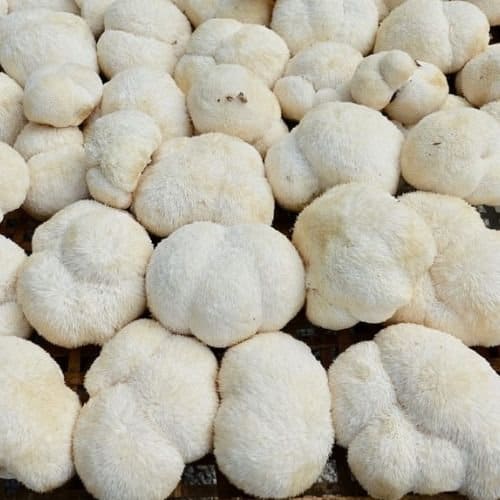
Species name: Hericium erinaceus
Primary Lion’s Mane Mushroom Medicinal Benefits: Supports healthy brain function & neuron generation*
Lion’s Mane is full of a multitude of important compounds, such as beta-glucans, which are immuno-modulating antioxidants and neuro-protective phytonutrients*. In vitro research suggests that certain compounds found in Lion’s mane, namely hericenones and erinacines, may help induce Nerve Growth Factor (NGF) synthesis in nerve cells [1]. This dovetails with findings from animal research that Lion’s mane promotes nerve tissue growth and supports motor function. And research in adults with mild memory problems associated with aging found that those taking Lion’s Mane extract had better brain function compared with control participants who did not ingest the mushroom [2]. All of this indicates that Lion’s Mane mushroom is an amazing helper for healthy brain function and may even support neurogenesis.
Historical Uses of Lion’s Mane Medicinal Mushrooms
Lion’s Mane, or Hericium erinaceus, is a species of mushroom that is beautiful in appearance; it has long cascading shaggy spines resembling a waterfall. Lion’s Mane grows on the trunks of hardwood trees in Northern forests.
Traditional Chinese Medicine (TCM), names Lion’s Mane Hou Tou Gu (monkey head mushroom). Chinese medicine practitioners use this mushroom for the spleen, and its association with digestion, energy, and water regulation. TCM also uses this medicinal mushrooms as a tonic for stress-related disorders (neurasthenia) and for a lack of energy (qi deficiency).
The Japanese call Lion’s Mane Yamabushitake, after the worshipping Buddhist monks known as the Shugendō. These monks used Lion’s Mane tea to increase their ability to concentrate during meditation. Indigenous peoples of pre-colonial US, Canada, and Australia also used Lion’s Mane for medicine and food. This mushroom has become a well-established candidate in promoting cognitive function.
Best Ways to Include Lions’ Mane Mushrooms in Your Daily Life
RAACKS offers a superb Lion’s Mane supplement that is full of beneficial compounds because efficacy is our top priority.
Reishi Mushroom: The Mushroom of Immortality
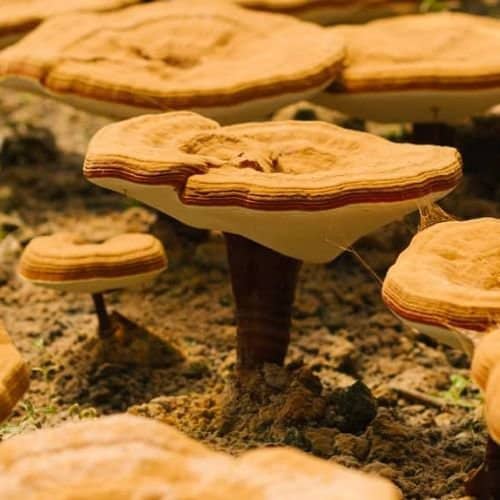
Species name: Ganoderma lingzhi
Primary Reishi Mushroom Medicinal Benefits: Sleep aid and potent immunomodulator*
The polysaccharides in reishi mushroom are associated with immune function, and if taken over time, reishi can significantly support the immune system*. It can also support restful sleep and a calm mind, reduce occasional stress and restlessness, can support lung and respiratory health, and support balanced blood sugar levels*.
One study has demonstrated that Reishi can decrease symptom scale scores for men experiencing lower urinary tract symptoms (urination difficulty) [22]. Reishi can be used safely in adjunct with certain oncology medications and diagnoses [23].
Because of its well-rounded capacity to support numerous systems in the body, herbalists call reishi the King of Medicinal Mushrooms.
Historical Uses of Reishi Medicinal Mushrooms
Reishi, or Ganoderma lingzhi, has a 2000-year-old written record in medicinal texts. Most notably, Chinese Taoist monks wrote of using it to promote calmness, as well as to enhance their meditative practices. Chinese royalty used reishi to promote longevity and held this “mushroom of immortality,” in high esteem. Reishi was listed as the most cherished among the superior herbs, which are considered to support a long life, support healthy aging, boost qi, and make the body light [3].
There are six different colors of reishi referenced in historical literature, each with their own unique benefits.
Cordyceps Mushroom: The Caterpillar Fungus
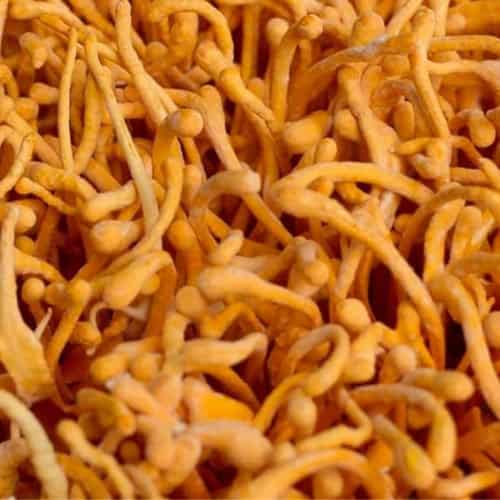
Species name: Cordyceps Militaris
Primary Cordyceps Mushroom Medicinal Benefits: Improves lung capacity and increases energy*
The cordyceps mushroom is an incredible energy-boosting fungi. Certain studies have shown that cordyceps can increase the production of ATP, the compound that gives cells energy, in rodents. This is why Cordyceps is a good mushroom supplement to take for exercise and physical performance*. In fact, two well-controlled clinical studies have found cordyceps improves exercise performance in healthy older individuals [4,5].
Preliminary research in humans, animals, and test tubes also indicates that cordyceps supports healthy levels of inflammation and immune markers.
Related cordyceps species may have hormone regulatory properties shown in research studies to increase libido (in women) and improve sperm health in men [27]. Cordyceps can support kidney health in certain populations [24, 25, 26].
Historical Uses of Cordyceps Medicinal Mushrooms
Old Chinese medical books and Tibetan medicine describe cordyceps as a treasure. With hundreds of different species, it is a parasitic fungus that preys on insects. Traditional healers use the fungus as a powerful tonic to improve energy, appetite, stamina, and endurance [6].
Cordyceps was traditionally used as a tonic because it has the capacity to revitalize and restore symptoms like fatigue, exhaustion, and chronic stress. Out of all the medicinal mushrooms, Cordyceps is the most stimulating, warming, and powerful in a traditional context. It has an affinity to the kidneys and lungs, meaning it supports these organs the most.
The Strange (And Expensive) Cordyceps Market
The most well-known species of cordyceps is Cordyceps sinensis; the most expensive mushroom in the world, costing over $20,000 per kilogram and sold almost exclusively in Asia. It is a rare combination of a caterpillar and a mushroom and is found at high altitudes in the Himalayan Plateau.
For many years, Chinese scientists weren’t able to cultivate this mushroom, fueling an increasing demand on a small supply. Now, with this particular fungus, it is very important to be aware of what you are consuming, because wild Cordyceps sinensis rarely makes it to the North American market, yet companies are still advertising Cordyceps sinensis on their mushroom supplements. If a cordyceps product is grown in North America, it is almost certainly myceliated grain. A high amount of grain means a low amount of mycelium and decreased beta-glucans, which are the beneficial polysaccharides found in the cell wall.
Luckily, there is one type of Cordyceps species that can be cultivated commercially to produce a mushroom (fruiting body), and that is Cordyceps militaris, which has similar benefits to Cordyceps sinensis. If you would like to dive deeper into the realm of this fungus, we have written an engaging and extensive article on cordyceps supplements to help you keep informed.
Chaga Mushroom: The Mushroom that’s not a Mushroom

Species name: Inonotus Obliquus
Primary Chaga Mushroom Medicinal Benefits: Boosts digestion and clears/protects skin
Chaga has been studied for its use in skin conditions and stomach disorders. Chaga has over 200 pre-clinical animal and cell studies showing promising health benefits including such as being high in antioxidants, supporting digestion, immune support, modulating inflammation, containing key anti-microbial substances, and being adaptogenic [7].
Historical Uses of Chaga
Chaga or Inonotus obliquus, which is commonly referred to as a mushroom, is actually a highly prized woody canker or conk that grows in the colder regions of the Northern Hemisphere on birch trees.
The first medicinal uses of chaga seem to have come out of Russia around the 16th century. Siberians would use chaga as a tea to enhance stomach health*. After 1966, Chaga gained more exposure after its powers were written about in Alexander Solzhenitsyn’s book, Le Pavillon des cancéreux. Many indigenous people continue to use Chaga around the world for varying health-supportive purposes.
How Chaga Grows Is the Key to Its Benefits
As Chaga grows primarily on birch trees and much of the mass itself is actually wood fiber and not mycelium, many medicinal compounds from birch like betulin and betulinic acid end up in the chaga. The outer black layer on the canker contains high amounts of melanin, which can be beneficial for our skin*.
Until recently, Chaga could not be cultivated, but now in Finland they are inoculating birch trees with this fungus. Lab-cultivated Chaga does not develop into canker, and as it does not grow on birch but on grain, it does not contain the important medicinal compounds that come from birch.
Turkey Tail Mushroom: The Mushroom of Multiple Colors
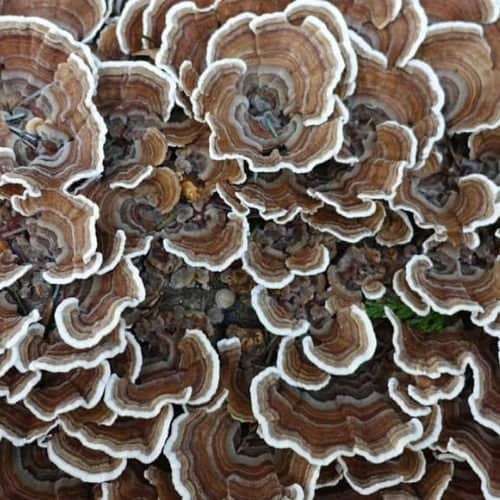
Species name: Trametes Versicolor
Primary Turkey Tail Mushroom Medicinal Benefit: Boosts immune system function
Turkey tail improves immune function by stimulating cytokine production, increasing natural killer cells, and through other immune-boosting functions*.
Protein-bound polysaccharides (PBP) found in Turkey Tail have the most research-backed immune-supportive effects. These PBP compounds can enhance key types of immune cells, like T-cells, when used alone or in combination with synergistic herbs [29]. Turkey Tail is a safe mushroom to use long-term within the context of proper medical treatment [23, 32].
Historical Uses of Turkey Tail Medicinal Mushrooms
Turkey Tail mushroom, or Trametes Versicolor, is one of the most common and local mushrooms to many peoples around the world. It grows on dead logs worldwide and received its name because its rings of brown and tan look like the tail feathers of turkey..
In TCM (Traditional Chinese Medicine) turkey tail has been used for supporting digestion, lung health, body fluid regulation, and supporting vitality. In Japan and China, a derivative of turkey tail has been used to strengthen the immune system [8]*. Turkey tail contains one of the highest amounts of beta-glucans of all mushrooms, which can help keep our immune systems healthy when used over an extended period of time*.
Shiitake Mushroom: The Fragrant Mushroom
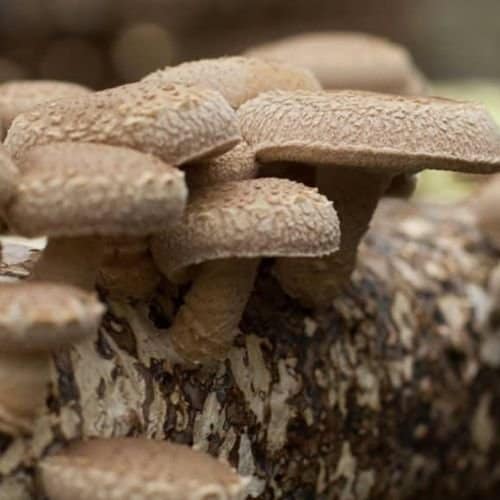
Species name: Lentinula edodes
Primary Shiitake Mushroom Medicinal Benefit: Supports cardiovascular health
Shiitake mushroom is great for immunity and liver health, and it supports the cardiovascular system*. Lentinan, a polysaccharide in shiitake mushrooms, has shown great promise as an immune system-boosting agent [9]*. Research has also discovered a compound in shiitake, eritadenine, that can help maintain cholesterol already within a healthy range [9]*. The mushrooms are great to cook with and are also loaded with B-vitamins, helping to modulate blood sugar levels in the body and support a healthy inflammation response.
Shiitake mushrooms have been shown to increase igA, a key immune cell (immunoglobulin) associated with our first line of defense when it comes to immunity [32]. Shiitake mushrooms can decrease C-Reactive Protein (CRP), a blood marker that detects inflammation [32].
Historical Uses of Shiitake Medicinal Mushrooms
Shiitake mushrooms are the most popular mushrooms in the world and have a meaty and versatile flavor, which is why they’ve been used as a food source in Asia for hundreds of years.
In China, shiitake is called Xiang gu (香菇), which translates to “fragrant mushroom.” During the Ming Dynasty in China, shiitake was deemed “the elixir of life”.
Shiitake mushrooms have been cultivated in Japan for centuries and received their name from the shii trees (related to beech and oak) they’re found growing on. Shiitake has long been used as both a food and a supplement in TCM, as it is thought to support a long healthy life and support healthy circulation*.
Maitake Mushroom: The Dancing Mushroom
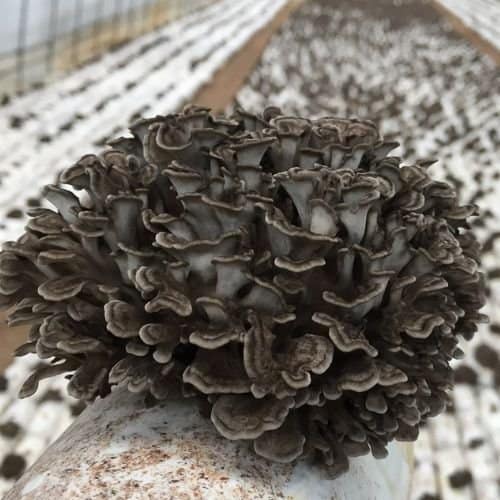
Species name: Grifola frondosa
Primary Maitake Mushroom Medicinal Benefits: Helps to maintain healthy blood pressure and supports immune function
Maitake mushrooms support immune function by stimulating the immune system’s lymphocytes, natural killer cells, monocytes, and T-helper cells* [10,11].
Historical Uses of Maitake Medicinal Mushrooms
Maitake, Grifola frondosa is commonly known as Hen of the Woods or the Dancing Mushroom. It is plentiful in the deciduous forests of North America and Japan. It is an edible mushroom with an earthy flavour. Traditional Chinese Medicine has used this mushroom for its support of the spleen, and for benefiting qi. The mushroom (fruiting body) contains polysaccharides such as beta-glucans, which have been linked to healthy cell growth and turnover*.
Maitake became quite famous in the 1990’s after Dr. Hiroaki Nanba, a pharmacologist at Kobe Pharmaceutical University in Japan, began isolating and testing different polysaccharide fractions from Maitake. Many of these fractions were quite potent immunomodulating agents.
3 Bonus Medicinal Mushrooms: Oyster, Agaricus, Tremella
Oyster Mushroom: The Carnivorous Fungus
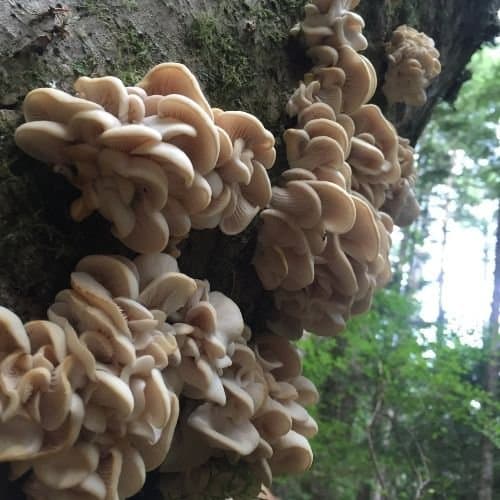
Mushrooms of the genus Pleurotus, most commonly P. ostreatus
Primary Oyster Mushroom Medicinal Benefits: Supports heart and metabolic health*
As one of the most actively cultivated edible mushrooms found worldwide, oyster mushrooms boast an excellent nutritional profile, including low calories, low fat, high protein, a wide range of vitamins and minerals (including niacin), and antioxidants.*
A number of research studies show that oyster mushrooms can improve immune system function against respiratory infections [33, 34, 35]. Oyster mushrooms have unique compounds contributing to the lowering of cholesterol known as lovastatin, ergothioneine, ergosterol, ACE-inhibiting peptides, and chrysin [36]. Lovastatin is a natural “statin” that inhibits cholesterol synthesis. Oysters have the capacity to help the body maintain healthy levels of cholesterol and triglycerides [37].
Oyster mushrooms are also renowned for their ability to help clean up environmental toxins and pests. This fascinating mushroom is one of the few species of carnivorous fungi, attacking and killing ne’er-do-wells with its extracellular toxins [12].
Historical Uses of Oyster Medicinal Mushrooms
The oyster mushroom, or Pleurotus ostreatus, gets its name from its shape and color, not its taste. This white, shell-shaped mushroom has a subtle but sweet, nutty taste and prefers to grow on dead hardwood trees, though the ease of its cultivation has resulted in its inclusion in many grow-at-home mushroom kits in recent years. P. ostreatus was first described by Nikolaus Joseph Freiherr von Jacquin in 1775, though he named it Agaricus ostreatus. It was transferred to the genus Pleurotus by German mycologist Paul Kummer in 1871.
How the Ergothioneine in Oyster Mushrooms Promotes Health
Beyond beta-glucans, oyster mushrooms are known for their stores of the compound ergothioneine (also known as l-ergothioneine), an unusual amino acid with powerful antioxidant properties that can only be derived from the diet.
Research studies have demonstrated that ergothioneine has cytoprotective (i.e. cell-protecting) properties [13]*, though there is a lack of human trials. The functional bioactive compounds in the oyster mushroom may also help maintain blood pressure already within a healthy range, support a healthy body weight, balance blood sugar levels, and support lipid metabolism, according to a systematic review of clinical trials [14]*.
Agaricus Mushroom: The Button
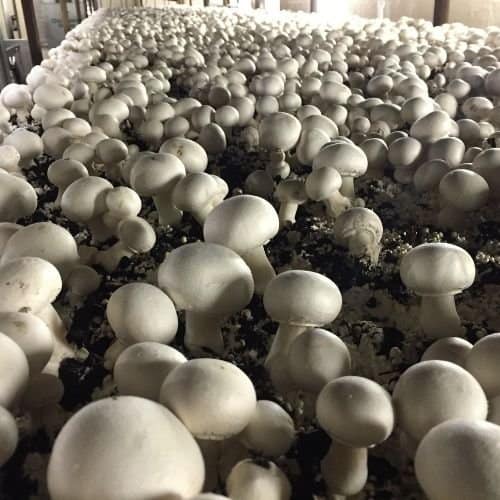
Species name: Agaricus bisporus
Primary Agaricus Mushroom Medicinal Benefits: Supports cardiovascular health and provides excellent levels of vitamin D*
Agaricus bisporus, often called “the button mushroom” or “the white mushroom,” dominates the U.S. commercial mushroom industry, representing approximately 90% of mushrooms consumed in the country [15]. It has become so common that many refer to it simply as “the mushroom.” With its pleasant taste, many people may think of this mushroom as just an ingredient on pizza or in a salad, but the agaricus mushroom provides numerous health benefits, including a substantial amount of vitamin D, the sunshine vitamin.
Agaricus mushrooms show positive modulation of PSA levels in those with prostate health concerns [38]. These mushrooms also have the capacity to increase bacteroidetes species in the microbiome, a theorized favourable shift for gut health [39].
Historical Uses of Agaricus Medicinal Mushrooms
While common, Agaricus bisporus is anything but boring. Historical evidence suggests that A. bisporus was first cultivated in France by botanist Joseph Pitton de Tournefort in 1707 [16]. TCM practitioners have used it to help regulate the body’s qi and to promote overall well-being. Recent research studies have also found that the carbohydrate profile of agaricus mushrooms may benefit gut health [17]*. It also contains ergothioneine and polyphenols that may support a healthy inflammation response and benefit cardiovascular health [16]*.
Agaricus as a Vegan Source of Vitamin D
Most notably, agaricus mushrooms are known for their vitamin D2 content. Mushrooms exposed to sunlight or UV radiation are an excellent vegan source of the incredibly important sunshine vitamin. Unfortunately, vitamin D deficiency has become all too common, particularly during the fall and winter months when days are shorter.
Tremella: The Snow Fungus
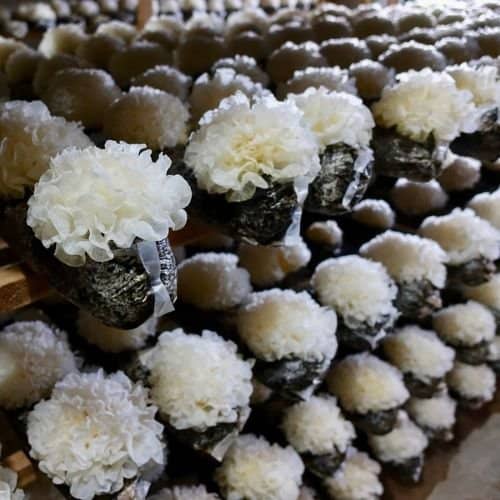
Species name: Tremella fuciformis
Primary Tremella Mushroom Medicinal Benefits: Promotes healthy, youthful complexion through potent anti-aging properties*
It may look a bit like a loofah, but don’t let its innocent appearance fool you — this mushroom may just be the beauty powerhouse you’ve been looking for. The unique polysaccharides found in Tremella fuciformis are known for their intense hydrating properties, much like hyaluronic acid, without the cost of high-end anti-aging cosmetic products. In fact, these polysaccharides are smaller than hyaluronic acid, allowing them to penetrate the skin more easily.
One study suggested that topical products with T. fuciformis polysaccharides (TFPS) had a better moisture retention rate than those with hyaluronic acid [19]*. Could the tremella mushroom be the next hyaluronic acid?
In addition to their remarkable hydrating properties, TFPS exhibit potent antioxidant, anti-aging, immune-boosting, gut-nourishing, and neuroprotective properties, though the mechanism behind these effects remains unclear [20,21]*.
Historical Uses of Tremella Medicinal Mushrooms
Tremella, or Tremella fuciformis, is a highly valued historical treasure of China. Due to the rarity of T. fuciformis in the wild, this gorgeous mushroom was once only available to royalty or the wealthy who could afford it. It has been said that concubine Yang Guifei —one of the “Four Great Beauties” of Chinese history — used the superfood to maintain her youthful appearance.
Despite its bland taste, tremella is still highly popular in China, where it is known as “yin er” (silver ear) or “baimuer” (snow ear). TCM practitioners have recommended tremella as a yin tonic for thousands of years to promote health, long life, and beauty. Being a stomach and lung yin tonic, TCM treatments of dry conditions include Tremella (dry cough, skin, throat, etc).
Understanding Medicinal Mushroom Supplement Benefits & Shopping Tips
As people are waking up to the powerful properties found in mushrooms, many companies are jumping on the trend and are producing or private-labeling mushroom supplements for the masses. The mushroom benefits for health maintenance are so unique because fungi adaptively support the health and resiliency of the human body.
These extremely intelligent organisms have been utilized in Asia for thousands of years for supporting immune strength and promoting a long and healthy life. However, in recent years the Western market in which these mushroom supplements are marketed and sold has few control standards. The result? A vast majority of the “mushroom” products sold in North America contain little to no mushrooms at all and are mostly mycelium and starch, from rice or other grains, ground up into a powder. This is an alarming fact about which most consumers are unaware. Let us explain why this fact should be of concern.
What is Mycelium? What is the Fruiting Body?
Mycelium is the root system of the mushroom; it is the precursor to the fruiting body we simply know as a mushroom. Mycelium and mushrooms are not synonymous.
The key active compounds found in mushrooms that research has linked to health benefits are: beta-D-glucans, triterpenoids, and ergosterol. These beneficial compounds occur in higher concentrations in the fruiting body, as opposed to the mycelium.
Health-Supporting Compounds in Mushrooms
Beta-D-glucans have been identified as primary sources of medicinal activity; they are a naturally occurring structural component of the cell walls of mushrooms that can activate or potentiate both innate and adaptive immunity.
Triterpenoids play a complementary role with beta-glucans in immune system activation; primary activities include: liver protection, antioxidant activity, histamine response, and inflammation response.
Ergosterol is present in all fungi, and it has recently been discovered to also have immunomodulating and antioxidant properties.
Final Takeaways: The Real Benefits of Medicinal Mushroom Supplements
That was a lot of information, yes? That’s because the Fungi Kingdom is one of the most diverse groups of organisms in the world. Fungi existed before any other terrestrial plants or animals, and they have spent billions of years learning how to adapt to any environmental threat. They play the important role of ecological decomposers while absorbing nutrition from the plant matter they live off of. As a result, mushrooms like lion’s mane, reishi, chaga, cordyceps, turkey tail, shiitake, and maitake offer a slew of health benefits. They share their power of resiliency and adaptation and the bio-compounds they absorb from other plants.
We are committed to providing you with real wisdom so that you can become empowered to start adding these super organisms into your diet right away! It is SO important to understand exactly what you’re consuming when it comes to mushroom supplements because of the lack of control standards on the market.
We truly believe that the quality of products you take determines the quality of your health, and we will continue to strive towards greatness and transparency in our process by offering you products that are made with genuine mushrooms, grown organically as nature intended.
“Let food be thy medicine and medicine be thy food.” -Hippocrates
SHOP OUR SUPPLEMENTS
References
- Lai, P. L., Naidu, M., Sabaratnam, V., Wong, K. H., David, R. P., Kuppusamy, U. R., Abdullah, N., & Malek, S. N. (2013). Neurotrophic properties of the Lion’s mane medicinal mushroom, Hericium erinaceus (Higher Basidiomycetes) from Malaysia. International journal of medicinal mushrooms, 15(6), 539–554. https://doi.org/10.1615/intjmedmushr.v15.i6.30
- Spelman, K., Sutherland, E., & Bagade, A. (2017). Neurological activity of Lion’s Mane (hericium erinaceus). Journal of Restorative Medicine, 6(1), 19–26. https://doi.org/10.14200/jrm.2017.6.0108
- Graff, A. (2006). (R. Upton & C. Petrone, Eds.) Reishi Mushroom Ganoderma lucidum Standards of Analysis, Quality Control, and Therapeutics. American Herbal Pharmacopoeia and Therapeutic Compendium. Retrieved November 1, 2021, from http://www.medicinacomplementar.com.br/biblioteca/pdfs/Fitoterapia/fi-0405.pdf.
- Chen, S., Li, Z., Krochmal, R., Abrazado, M., Kim, W., & Cooper, C. B. (2010). Effect of CS-4® (cordyceps sinensis) on exercise performance in healthy older subjects: A double-blind, placebo-controlled trial. The Journal of Alternative and Complementary Medicine, 16(5), 585–590. https://doi.org/10.1089/acm.2009.0226
- Yi, X., Xi-zhen, H. & Jia-shi, Z. Randomized double-blind placebo-controlled clinical trial and assessment of fermentation product of Cordyceps sinensis (Cs-4) in enhancing aerobic capacity and respiratory function of the healthy elderly volunteers. Chin. J. Integr. Med. 10, 187–192 (2004). https://doi.org/10.1007/BF02836405
- Panda, A. K., & Swain, K. C. (2011). Traditional uses and medicinal potential of Cordyceps sinensis of Sikkim. Journal of Ayurveda and integrative medicine, 2(1), 9–13. https://doi.org/10.4103/0975-9476.78183
- MediLexicon International. (n.d.). Chaga mushrooms: Benefits, tips, and risks. Medical News Today. Retrieved November 2, 2021, from https://www.medicalnewstoday.com/articles/318527#Nine-potential-benefits.
- PDQ Integrative, Alternative, and Complementary Therapies Editorial Board. Medicinal Mushrooms (PDQ®): Patient Version. 2021 Jul 28. In: PDQ Cancer Information Summaries [Internet]. Bethesda (MD): National Cancer Institute (US); 2002-. Available from: https://www.ncbi.nlm.nih.gov/books/NBK424937/
- Bisen, P. S., Baghel, R. K., Sanodiya, B. S., Thakur, G. S., & Prasad, G. B. (2010). Lentinus edodes: a macrofungus with pharmacological activities. Current medicinal chemistry, 17(22), 2419–2430. https://doi.org/10.2174/092986710791698495
- Inoue, A., Kodama, N., & Nanba, H. (2002). Effect of maitake (Grifola frondosa) D-fraction on the control of the T lymph node Th-1/Th-2 proportion. Biological & pharmaceutical bulletin, 25(4), 536–540. https://doi.org/10.1248/bpb.25.536
- Kodama, N., Komuta, K., & Nanba, H. (2003). Effect of Maitake (Grifola frondosa) D-Fraction on the activation of NK cells in cancer patients. Journal of medicinal food, 6(4), 371–377. https://doi.org/10.1089/109662003772519949
- G. L. Barron and R. G. Thorn. Destruction of nematodes by species of Pleurotus. Canadian Journal of Botany. 65(4): 774-778. https://doi.org/10.1139/b87-103
- Paul, B., Snyder, S. The unusual amino acid L-ergothioneine is a physiologic cytoprotectant. Cell Death Differ 17, 1134–1140 (2010). https://doi.org/10.1038/cdd.2009.163
- Dicks, L., & Ellinger, S. (2020). Effect of the Intake of Oyster Mushrooms (Pleurotus ostreatus) on Cardiometabolic Parameters-A Systematic Review of Clinical Trials. Nutrients, 12(4), 1134. https://doi.org/10.3390/nu12041134
- Ren, Z., Guo, Z., Meydani, S. N., & Wu, D. (2008). White button mushroom enhances maturation of bone marrow-derived dendritic cells and their antigen presenting function in mice. The Journal of Nutrition, 138(3), 544–550. https://doi.org/10.1093/jn/138.3.544
- Bhushan A, Kulshreshtha M. The Medicinal Mushroom Agaricus bisporus: Review of Phytopharmacology and Potential Role in the Treatment of Various Diseases. J Nat Sci Med 2018;1:4-9
- Hess, J., Wang, Q., Gould, T., & Slavin, J. (2018). Impact of Agaricus bisporus Mushroom Consumption on Gut Health Markers in Healthy Adults. Nutrients, 10(10), 1402. https://doi.org/10.3390/nu10101402
- Keegan, R. J., Lu, Z., Bogusz, J. M., Williams, J. E., & Holick, M. F. (2013). Photobiology of vitamin D in mushrooms and its bioavailability in humans. Dermato-endocrinology, 5(1), 165–176. https://doi.org/10.4161/derm.23321
- Wu, Y., Choi, M.-H., Li, J., Yang, H., & Shin, H.-J. (2016). Mushroom Cosmetics: The Present and Future. In Cosmetics (Vol. 3, Issue 3, p. 22). MDPI AG. https://doi.org/10.3390/cosmetics3030022
- Wu, Y.-ji, Wei, Z.-xun, Zhang, F.-ming, Linhardt, R. J., Sun, P.-long, & Zhang, A.-qiang. (2019). Structure, bioactivities and applications of the polysaccharides from Tremella Fuciformis Mushroom: A Review. International Journal of Biological Macromolecules, 121, 1005–1010. https://doi.org/10.1016/j.ijbiomac.2018.10.117
- Shen, T., Duan, C., Chen, B., Li, M., Ruan, Y., Xu, D., Shi, D., Yu, D., Li, J., & Wang, C. (2017). Tremella fuciformis polysaccharide suppresses hydrogen peroxide-triggered injury of human skin fibroblasts via upregulation of SIRT1. Molecular medicine reports, 16(2), 1340–1346. https://doi.org/10.3892/mmr.2017.6754
- Noguchi, M., Kakuma, T., Tomiyasu, K., Yamada, A., Itoh, K., Konishi, F., Kumamoto, S., Shimizu, K., Kondo, R., & Matsuoka, K. (2008). Randomized clinical trial of an ethanol extract of Ganoderma lucidum in men with lower urinary tract symptoms. Asian journal of andrology, 10(5), 777–785. https://doi.org/10.1111/j.1745-7262.2008.00361.x
- Lam, C. S., Cheng, L. P., Zhou, L. M., Cheung, Y. T., & Zuo, Z. (2020). Herb-drug interactions between the medicinal mushrooms Lingzhi and Yunzhi and cytotoxic anticancer drugs: a systematic review. Chinese medicine, 15, 75. https://doi.org/10.1186/s13020-020-00356-4
- Li, Y., Xue, W. J., Tian, P. X., Ding, X. M., Yan, H., Pan, X. M., & Feng, X. S. (2009). Clinical application of Cordyceps sinensis on immunosuppressive therapy in renal transplantation. Transplantation proceedings, 41(5), 1565–1569. https://doi.org/10.1016/j.transproceed.2009.02.085
- Lu L. (2002). Zhongguo Zhong xi yi jie he za zhi Zhongguo Zhongxiyi jiehe zazhi = Chinese journal of integrated traditional and Western medicine, 22(3), 169–171.
- Sun, T., Dong, W., Jiang, G., Yang, J., Liu, J., Zhao, L., & Ma, P. (2019). Cordyceps militaris Improves Chronic Kidney Disease by Affecting TLR4/NF-κB Redox Signaling Pathway. Oxidative medicine and cellular longevity, 2019, 7850863. https://doi.org/10.1155/2019/7850863
- Jiraungkoorskul, K., & Jiraungkoorskul, W. (2016). Review of Naturopathy of Medical Mushroom, Ophiocordyceps Sinensis, in Sexual Dysfunction. Pharmacognosy reviews, 10(19), 1–5. https://doi.org/10.4103/0973-7847.176566
- He, T., Zhao, R., Lu, Y., Li, W., Hou, X., Sun, Y., Dong, M., & Chen, L. (2016). Dual-Directional Immunomodulatory Effects of Corbrin Capsule on Autoimmune Thyroid Diseases. Evidence-based complementary and alternative medicine : eCAM, 2016, 1360386. https://doi.org/10.1155/2016/1360386
- Wong, C. K., Tse, P. S., Wong, E. L., Leung, P. C., Fung, K. P., & Lam, C. W. (2004). Immunomodulatory effects of yun zhi and danshen capsules in health subjects–a randomized, double-blind, placebo-controlled, crossover study. International immunopharmacology, 4(2), 201–211. https://doi.org/10.1016/j.intimp.2003.12.003
- Donatini B. (2014). Control of oral human papillomavirus (HPV) by medicinal mushrooms, Trametes versicolor and Ganoderma lucidum: a preliminary clinical trial. International journal of medicinal mushrooms, 16(5), 497–498. https://doi.org/10.1615/intjmedmushrooms.v16.i5.80
- Wong, C. K., Tse, P. S., Wong, E. L., Leung, P. C., Fung, K. P., & Lam, C. W. (2004). Immunomodulatory effects of yun zhi and danshen capsules in health subjects–a randomized, double-blind, placebo-controlled, crossover study. International immunopharmacology, 4(2), 201–211. https://doi.org/10.1016/j.intimp.2003.12.003
- Chen, J. T., Tominaga, K., Sato, Y., Anzai, H., & Matsuoka, R. (2010). Maitake mushroom (Grifola frondosa) extract induces ovulation in patients with polycystic ovary syndrome: a possible monotherapy and a combination therapy after failure with first-line clomiphene citrate. Journal of alternative and complementary medicine (New York, N.Y.), 16(12), 1295–1299. https://doi.org/10.1089/acm.2009.0696
- Minov, J., Bislimovska-Karadzhinska, J., Petrova, T., Vasilevska, K., Stoleski, S., & Mijakoski, D. (2017). Effects of Pleuran (Β-Glucan from Pleurotus Ostreatus) Supplementation on Incidence and Duration of COPD Exacerbations. Open access Macedonian journal of medical sciences, 5(7), 893–898. https://doi.org/10.3889/oamjms.2017.198
- Jesenak, M., Hrubisko, M., Majtan, J., Rennerova, Z., & Banovcin, P. (2014). Anti-allergic effect of Pleuran (β-glucan from Pleurotus ostreatus) in children with recurrent respiratory tract infections. Phytotherapy research : PTR, 28(3), 471–474. https://doi.org/10.1002/ptr.5020
- Jesenak, M., Urbancikova, I., & Banovcin, P. (2017). Respiratory Tract Infections and the Role of Biologically Active Polysaccharides in Their Management and Prevention. Nutrients, 9(7), 779. https://doi.org/10.3390/nu9070779
- Anandhi, R., Annadurai, T., Anitha, T. S., Muralidharan, A. R., Najmunnisha, K., Nachiappan, V., Thomas, P. A., & Geraldine, P. (2013). Antihypercholesterolemic and antioxidative effects of an extract of the oyster mushroom, Pleurotus ostreatus, and its major constituent, chrysin, in Triton WR-1339-induced hypercholesterolemic rats. Journal of physiology and biochemistry, 69(2), 313–323. https://doi.org/10.1007/s13105-012-0215-6
- Schneider, I., Kressel, G., Meyer, A., Krings, U., Berger, R. G., & Hahn, A. (2011). Lipid lowering effects of oyster mushroom (Pleurotus ostreatus) in humans. Journal of Functional Foods, 3(1), 17-24.
- Twardowski, P., Kanaya, N., Frankel, P., Synold, T., Ruel, C., Pal, S. K., Junqueira, M., Prajapati, M., Moore, T., Tryon, P., & Chen, S. (2015). A phase I trial of mushroom powder in patients with biochemically recurrent prostate cancer: Roles of cytokines and myeloid-derived suppressor cells for Agaricus bisporus-induced prostate-specific antigen responses. Cancer, 121(17), 2942–2950. https://doi.org/10.1002/cncr.29421
- Hess, J., Wang, Q., Gould, T., & Slavin, J. (2018). Impact of Agaricus bisporus Mushroom Consumption on Gut Health Markers in Healthy Adults. Nutrients, 10(10), 1402. https://doi.org/10.3390/nu10101402
- Li, J., Zou, L., Chen, W., Zhu, B., Shen, N., Ke, J., Lou, J., Song, R., Zhong, R., & Miao, X. (2014). Dietary mushroom intake may reduce the risk of breast cancer: evidence from a meta-analysis of observational studies. PloS one, 9(4), e93437. https://doi.org/10.1371/journal.pone.0093437
- Zhang, M., Huang, J., Xie, X., & Holman, C. D. (2009). Dietary intakes of mushrooms and green tea combine to reduce the risk of breast cancer in Chinese women. International journal of cancer, 124(6), 1404–1408. https://doi.org/10.1002/ijc.24047
Disclaimer: The information or products mentioned in this article are provided as information resources only, and are not to be used or relied on to diagnose, treat, cure, or prevent any disease. This information does not create any patient-doctor relationship, and should not be used as a substitute for professional diagnosis and treatment. The information is intended for health care professionals only. The statements made in this article have not been evaluated by the Food and Drug Administration. Any products mentioned are not intended to diagnose, treat, cure, or prevent any disease. The information in this article is intended for educational purposes. The information is not intended to replace medical advice offered by licensed medical physicians. Please consult your doctor or health practitioner for any medical advice.
